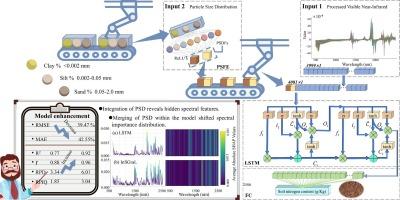通过可见光-近红外光谱加强土壤氮素测量:将土壤粒径分布与长短期记忆模型相结合
IF 4.3
2区 化学
Q1 SPECTROSCOPY
Spectrochimica Acta Part A: Molecular and Biomolecular Spectroscopy
Pub Date : 2024-10-22
DOI:10.1016/j.saa.2024.125317
引用次数: 0
摘要
高质量的土壤氮数据对提高农业管理水平和改善生态环境都至关重要,但传统上都依赖于劳动密集型的化学程序。可见近红外(Vis-NIR)光谱法因其高效、环境兼容性和快速性而被公认为是一种很有前途的替代方法。然而,可见近红外光谱测量模型的有效性受到土壤粒度分布(PSD)的严重影响,为提高测量精度和可靠性带来了巨大挑战。本文提出了一种创新的深度学习方法,将粒度分布与可见光-近红外光谱技术相结合,用于测量土壤样本中的氮含量。通过利用 LUCAS 数据集,探索了在深度学习模型中整合 PSD 与可见光-近红外光谱数据的不同策略,结果表明,我们提出的 InSGraL 框架将 PSD 和光谱的混合特征作为 LSTM 输入,实现了卓越的性能。与仅使用可见光-近红外数据的模型相比,InSGraL 的 RMSE 降低了 39.47%,MAE 降低了 42.55%,并在各种土地覆被类型中表现出稳健的性能,在草地样本上的 R2 达到了 0.94。此外,Shapley Additive exPlanations(SHAP)分析表明,加入 PSD 可改变光谱输入重要性分布,有效减轻粒度对光谱的干扰,同时突出以前被遮挡的关键波长。这项研究提供了一种创新的建模策略,通过将 PSD 整合到 Vis-NIR 深度学习框架中来减轻 PSD 的影响,从而加深了对 PSD 与 Vis-NIR 光谱之间关系的理解,有助于测量氮含量,并为获得土壤氮数据提供了一种有效的方法。本文章由计算机程序翻译,如有差异,请以英文原文为准。

Enhancing soil nitrogen measurement via visible-near infrared spectroscopy: Integrating soil particle size distribution with long short-term memory models
Good quality of soil nitrogen data, which is essential for the advancement of both enhanced agricultural management and ecological environment, traditionally depends on labor intensive chemical procedures. Visible near-infrared (Vis-NIR) spectroscopy, acknowledged for its efficiency, environmental compatibility and rapidity, merges as a promising alternative. However, the effectiveness of Vis-NIR measurement models are significantly compromised by soil particle size distribution (PSD), presenting a substantial challenge in improving the measurement accuracy and reliability. Here an innovative deep learning methodology that integrates PSD with Vis-NIR spectroscopy was proposed for the measurement of nitrogen content in soil samples. By leveraging the LUCAS dataset, different strategies for integrating PSD with Vis-NIR spectral data in deep learning models were explored, revealing that our proposed InSGraL framework, which incorporated mixed features of PSD and spectra as LSTM inputs achieves superior performance. Compared to models utilizing solely Vis-NIR data, InSGraL exhibits a 39.47 % reduction in RMSE and a 42.55 % decrease in MAE, and demonstrates robust performance across various land cover types, achieving an R2 of 0.94 on grassland samples. Moreover, Shapley Additive exPlanations (SHAP) analysis revealed that incorporating PSD modifies the spectral input importance distribution, effectively mitigating spectral interference from particle size while highlighting critical wavelengths previously obscured. This study provides an innovative modeling strategy to mitigate the influence of PSD by integrating it within deep learning framework using Vis-NIR, contributing a deeper understanding of the relationship between PSD and Vis-NIR spectra for the measurement of nitrogen content and offering an effective means to attain soil nitrogen data.
求助全文
通过发布文献求助,成功后即可免费获取论文全文。
去求助
来源期刊
CiteScore
8.40
自引率
11.40%
发文量
1364
审稿时长
40 days
期刊介绍:
Spectrochimica Acta, Part A: Molecular and Biomolecular Spectroscopy (SAA) is an interdisciplinary journal which spans from basic to applied aspects of optical spectroscopy in chemistry, medicine, biology, and materials science.
The journal publishes original scientific papers that feature high-quality spectroscopic data and analysis. From the broad range of optical spectroscopies, the emphasis is on electronic, vibrational or rotational spectra of molecules, rather than on spectroscopy based on magnetic moments.
Criteria for publication in SAA are novelty, uniqueness, and outstanding quality. Routine applications of spectroscopic techniques and computational methods are not appropriate.
Topics of particular interest of Spectrochimica Acta Part A include, but are not limited to:
Spectroscopy and dynamics of bioanalytical, biomedical, environmental, and atmospheric sciences,
Novel experimental techniques or instrumentation for molecular spectroscopy,
Novel theoretical and computational methods,
Novel applications in photochemistry and photobiology,
Novel interpretational approaches as well as advances in data analysis based on electronic or vibrational spectroscopy.

 求助内容:
求助内容: 应助结果提醒方式:
应助结果提醒方式:


